Osteoporosis detection by a simple physical function test

Osteoporosis is a condition that does not exhibit symptoms until there is a bone fracture, so a large percentage of patients remain unaware of their condition. When people are unaware their bones have weakened, the condition is left untreated, and the recent rise of the elderly population has caused an increase in bone fractures. This has a large societal impact, such as overwhelming medical costs and increased need for long-term care. Simple screenings at resident health exams are one way for an increase in osteoporosis detection without having to go to the hospital. When suspected osteoporosis and osteopenia is properly detected and patients are encouraged to get further evaluation at the hospital, they can receive appropriate treatment. This study developed a novel method to detect untreated osteoporosis through a low-cost, physical function test during a routine health checkup.
Osteoporosis is under-diagnosed, and when left untreated it can lead to serious fractures that can reduce mobility, living function, and life expectancy. With proper treatment, people are more likely to avoid serious fractures. Doctors and physical therapists at Shinshu University Hospital developed a method to detect possible osteoporosis before going to the hospital. If this detection determines that a patient is likely to have osteoporosis, patients will then be encouraged to have a bone-density test at the hospital.
This study was conducted by a random sampling of the Resident Register. Results are expected to be closer to the actual demographic of the general population than surveys targeting hospital patients and specific volunteers. The osteoporosis detection method used the combination of BMI and a two-step test which is performed by taking two maximum-stride steps and calculating the distance in centimeters divided by the body height in centimeters. This showed a high osteoporosis detection capability that even FOSTA could not achieve, despite the cost of the test being close to zero. The study, which targeted postmenopausal women who are at high risk for primary osteoporosis, found that if any of the following is true, TST <= 1.30 and BMI <= 23.4, TST <= 1.32 and BMI <= 22.4, TST <= 1.34 and BMI <= 21.6, or TST < 1.24 and any BMI, the subject is more than five times more likely to have osteoporosis than someone who is not. (Abbreviation: TST, two-step test; BMI, body mass index.)
Source: Read Full Article
